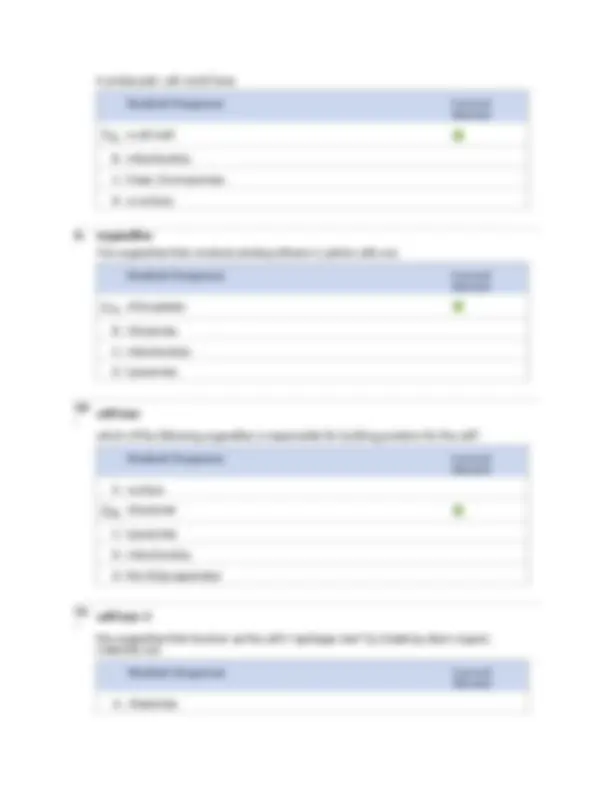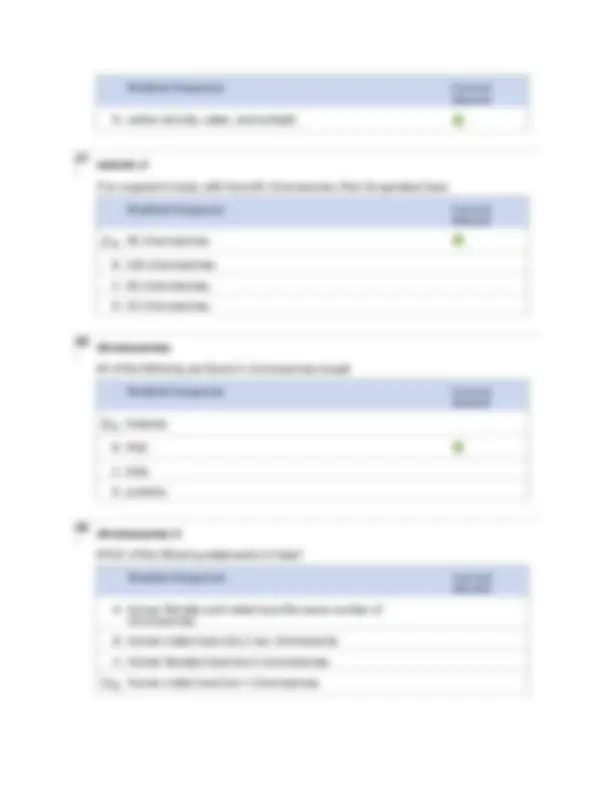











Study with the several resources on Docsity

Earn points by helping other students or get them with a premium plan


Prepare for your exams
Study with the several resources on Docsity

Earn points to download
Earn points by helping other students or get them with a premium plan
Community
Ask the community for help and clear up your study doubts
Discover the best universities in your country according to Docsity users
Free resources
Download our free guides on studying techniques, anxiety management strategies, and thesis advice from Docsity tutors
Material Type: Exam; Professor: Heard; Class: Life/Earth Science; Subject: Integrated Science; University: University of West Georgia; Term: Fall 2010;
Typology: Exams
1 / 16

This page cannot be seen from the preview
Don't miss anything!










1. Characteristics of Living organisms Which of the following is not a characteristic of living things? Student Response Correct Answer A. Living things convert energy from one form to another. B. Living things are part of populations that evolve. C. Living things allow their internal environment to match the conditions of the external environment. D. Living things develop and grow. 2. Macromolecules needed for life Cellulose, the macromolecule that make up a plant's cell wall, is a Student Response Correct Answer A. lipid B. carbohydrate C. protein D. nucleic acid 3. Macromolecules needed for life 2 Nucleic acids Student Response Correct Answer A. store genetic information in living organisms. B. consists of folded strings of amino acids. C. store energy in living organisms. D. act as hormones that allow cells to communicate with one another. 4. protein function Which of the following is NOT a function of proteins? Student Response Correct Answer A. proteins are important in cell signalling.
Answer B. proteins are an important source of stored energy. C. proteins catalize chemical reactions in the body. D. proteins help cells adhere (stick) to each other.
5. Saturated fats Which of the following statements is TRUE for saturated fats? Student Response Correct Answer A. saturated fats have been assiciated with coronary heart disease. B. saturated fats have no double bonds between thier carbon atoms. C. saturated fats have a longer shelf life that other fats. D. all of the above are correct. E. none of the above are correct. 6. Cell types: pro vs eukaryotic cells One difference between prokaryotic and eukaryotic cells is that Student Response Correct Answer A. prokaryotic cells have a nucleus, while eukaryotic cells do not have a nucleus. B. the DNA of prokaryotic cells exist as linear chromosomes, while the DNA of eukaryotes is a single circular chromosome. C. most of the time eukaryotic cells are smaller than prokaryotic cells. D. prokaryotic cells have existed on Earth far longer that eukaryotic cells have existed. 7. archea and bacteria Archea cells are eukaryotes, while Bacteria are prokaryotes. Student Response Correct Answer True False 8. prokaryotes vs eukaryotes
Answer B. mitochondria. C. perixosomes. D. lysosomes. 12 . cell membrane 2 Which of the following is not a component of the cell membrane? Student Response Correct Answer A. phospholipids. B. carbohydrates C. short RNA strands. D. proteins. 13 . cell transport What form of transport across the cell membrane does not require energy, but does require a carrier protein? Student Response Correct Answer A. passive diffusion. B. endocytosis. C. active transport. D. facilitated diffusion. E. pinocytosis. 14 . na k pump the sodium - potassium (Na+ ; K+) pump provides an example of Student Response Correct Answer A. active transport
Answer B. facilitated diffusion. C. endocytosis. D. diffusion. 15 . osmosis 2 In the process of osmosis, Student Response Correct Answer A. water diffuses from an area with a high concentration of water molecules to an area with a low concentration of water molecules. B. water moves from an area of lower solute concentration to an area of higher solute concentratuion. C. water moves into cells. D. both A and B. E. all of the above. 16
. transport mechanisms Which of the following processes is used by a white blood cell to capture bacteria? Student Response Correct Answer A. pinocytosis. B. endocytosis C. diffusion. D. exocytosis. 17 . cellular communication Gap junctions in animal cells Student Response Correct Answer A. are tiny channels that connect the cytoplasm of two cells.
Answer B. synthesis. C. gap 1. D. mitosis. 21 . cell cycle 2 During which phase of the cell cycle does the cell reproduce its DNA (genetic material)? Student Response Correct Answer A. gap 2. B. mitosis. C. synthesis. D. gap 1. 22 . crossing over What event has occured in the shown diagram? Student Response Correct Answer A. mitosis. B. metaphase. C. crossing over. D. switching over. E. cytokenesis. 23 . enzymes 2 Enzymes are Student Response Correct Answer A. catalysts.
Answer B. proteins. C. inhibitors. D. both A and B 24 . cellular respiration 2 During which of the following processes is the most ATP generated? Student Response Correct Answer A. Krebs cycle. B. glycolysis C. electron transport (chain). D. fermentation. 25 . Cellular respiration 3 During alcoholic fermentation, Student Response Correct Answer A. lactic acid is produced. B. oxygen is used. C. carbon dioxide is produced. D. water is released. 26
. photosynthesis The reactants in the process of photosynthesis are Student Response Correct Answer A. glucose. B. glucose and oxygen. C. carbon dioxide and water.
Answer E. Human males have a Y chromosome. 30
. DNA structure If one strand of DNA has the sequence CAGTC, then the opposite strand will have the sequence Student Response Correct Answer A. GTCAG. B. GUCAG. C. ATCGA. D. TCAGT. 31 . DNA structure 2 If DNA is described as have a ladder like structure, the 'sides' of the ladder are composed of _________, and the 'rungs' of the ladder are composed of _______. Student Response Correct Answer A. sugar and nitrogeneous bases; phosphate B. sugar and phospholipids; nitrogeneous bases C. sugar; phosphate D. sugar and phosphate; nitrogeneous bases 32 . DNA replication 3 When DNA is replicated in eukaryotes, Student Response Correct Answer A. a molecule of messenger RNA (mRNA) is constructed using DNA as a template. B. the new molecule of DNA includes the bases A, C, T, and U. C. each new strand of DNA is composed of one old strand and one new strand.
Answer D. the new molecule of DNA cocsists of two new strands of DNA. 33 . transcription and translation The proper sequence of events in building a protein from a gene is Student Response Correct Answer A. transcription, translation. B. translation, transcription, replication. C. replication, transcription, translation. D. translation, transcription. 34 . transcrip and translat Which of the following statements regarding transcription and translation is true? Student Response Correct Answer A. A codon consists of two bases. B. The tRNA molecule includes a codon sequence and carries a single amino acid. C. mRNA includes the bases A, T, C, and G. D. teh mRNA transcript may contain introns that are removed before translation. 35 . DNA vs RNA 2 RNA and DNA differ in all of the following except: Student Response Correct Answer A. RNA is single stranded rather than double stranded. B. RNA uses a different sugar than DNA. C. RNA uses a completely different set of nitrogeneous bases than DNA. D. RNA uses the nitrogeneous base uracil in place of thymine.
Answer B. It is important for allowing chromosomes to exchange corresponding parts with their homologues. C. It produces haploid cells. D. It occurs in all cells in the human body. 40 . Mendellian genetics When Mendel crossed pea plants with green seeds with pea plants with yellow seeds, all of the offspring had yellow seeds. This means that the trait for yellow seed color is Student Response Correct Answer A. recessive. B. homozygous. C. heterozygous. D. domonant. 41 . mendellian genetics 2 If a widow's peak hairline is dominant and a straight hairline is recessive, then Student Response Correct Answer A. all of the children of two widow-peaked parents will have widow's peaks. B. some of the children of two straight-hairline parents could have widow's peaks. C. all of the children of two straight-hairline parents will have straight hairlines. D. some of the children of two widow-peaked parents will have straight hairlines. 42
. Mendellian genetics 3 If a widow's peak hairline is dominant and a straight hairline is recessive, then a person with a Student Response Correct Answer A. widow's peak hairline must be a heterozygote.
Answer B. straight hairline must be a heterozygote. C. straight hairline must be a homozygote. D. widow's peak hairline must be a homozygote. 43 . inheritance The fact that a red-flowered snapdragon bred to a white snapdragon produces pink- flowered offspring is an example of Student Response Correct Answer A. blending inheritance. B. pleiotropy. C. incomplete dominance. D. coodominance. 44 . inheritance 2 The A,B, O bloodtype in humans is an example of Student Response Correct Answer A. coodominance B. polygenetic traits. C. pleiotropy. D. incomplete dominance. 45 . inheritance 3 Human height and skin color are examples of Student Response Correct Answer A. pleiotropy. B. polygenic traits. C. coodominance.
What sex is the following human as determined from the karyotype? Student Response Correct Answer A. Male. B. Female. C. can not determine. 50
. inhibitors The reactants of a reaction bind to an enzyme's ___________, as does a ______________ of the enzyme. Student Response Correct Answer A. active site; competetive inhibitor B. substrate; competetive inhibitor C. substrate; noncompetetive inhibitor D. active site; noncompetetive inhibitor